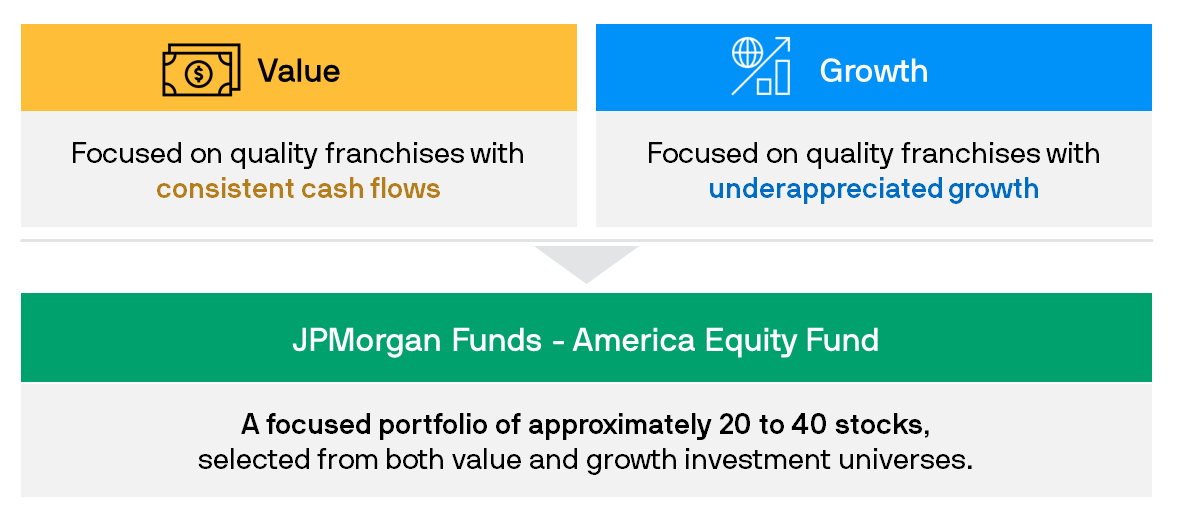
Positive earnings beat, a soft landing outcome and the potential for Fed easing later this year could present significant tailwinds for US stocks. Nevertheless, we believe it is important to stay mindful of the downside risks. An active approach could be useful to tap into higher quality opportunities amid wide intra-sector valuation and performance dispersion while managing the risks.
Important Information
1. The Fund invests primarily in a concentrated portfolio of US companies.
2. The Fund is therefore exposed to risks related to equity, concentration, currency, derivative, hedging, class currency and currency hedged share classes. For currency hedged share classes, the currency hedging process may not give a precise hedge and there is no guarantee that the hedging will be totally successful.
3. The Fund may at its discretion pay dividends out of capital. The Fund may also at its discretion pay dividends out of gross income while charging all or part of the Fund’s fees and expenses to the capital of the Fund, resulting in an increase in distributable amount for the payment of dividends and therefore, effectively paying dividends out of realised, unrealised capital gains or capital. Investors should note that, share classes of the Fund which pay dividends may distribute not only investment income, but also realised and unrealised capital gains or capital. Payment of dividends out of capital amounts to a return or withdrawal of part of an investor’s original investment or from any capital gains attributable to that original investment. Any dividend payments, irrespective of whether such payment is made up or effectively made up out of income, realised and unrealised capital gains or capital, may result in an immediate reduction of the net asset value per share. Also, a positive distribution yield does not imply a positive return on the total investment.
4. Investors may be subject to substantial losses.
5. Investors should not solely rely on this document to make any investment decision.
The outlook for US stocks remains constructive…
US stocks recorded a strong first quarter, with the S&P 500 index registering price gains of over 10% year-to-date (as of 31.03.2024) and notching 22 record highs in the span of three months1
For investors who had stayed on the sidelines, many could be wondering if they had missed an attractive opportunity. Meanwhile, others may question if the rally is sustainable.
In our view, we believe US stocks are in a sweet spot, for three key reasons.
1. History suggests strength begets more strength
First, historical data suggests that there is no clear advantage or disadvantage of investing in US stocks at record highs relative to any other time. Over the last 50+ years since 1970, the average 12-month price return of the S&P 500 index after reaching an all-time high was 9.1%, while the average price return from investing all other days was 8.7%2.
Historically, investing at all-time highs has not meaningfully impacted longer-term returns.

Source: Haver Analytics, J.P. Morgan Asset Management. Data as of 06.02.2024.
2. Macro tailwinds from a soft landing and potential policy easing
Second, the outlook of the US economy remains constructive. Despite fears of a hard landing amid restrictive interest rates and a short-lived regional banking crisis, the US economy still expanded more than 3% in the fourth quarter of 20233. Crucially, the US consumer remained resilient, supported by record low unemployment and higher real wage growth as inflation cooled. The wealth effect from rising asset prices such as equities and housing could continue to support actual consumer spending as richer consumers tend save less and spend more. With consumption accounting for around 70% of US gross domestic product (GDP)4, a resilient consumer presents a solid foundation for continued economic expansion, albeit at a slower pace from last year.
US consumers have remained resilient, supported by a low unemployment rate, tight labour market and rising wages.

Source: Bureau of Labor Statistics, Federal Reserve Economic Data (FRED), J.P. Morgan Asset Management. Data as of 31.03.2024. Wage growth is calculated from the wages of private production and non-supervisory workers, seasonally adjusted. Private production and non-supervisory jobs represent just over 80% of total non-farm jobs.
More importantly, a potential monetary policy pivot later in the year could provide some additional tailwind. As the recent Federal Open Market Committee (FOMC) meeting in March showed, the median FOMC member continues to maintain a somewhat dovish bias, projecting around three rate cuts this year based on the dot plot, although policymakers had trimmed rate cut projections in 20255.
A soft landing outcome coupled with the potential for some monetary easing later this year could present a constructive backdrop for US equities. Indeed, historical data bears this out. In the 44 years since 1980, there were 14 non-recession years when the Fed had cut interest rates at least once2. Price returns for the S&P 500 index was positive for 13 of those 14 years – or 93% of the time – with an average price gain of 15.6%2.
3. Earnings paint a positive picture
Third, earnings for US companies continue to paint a relatively positive picture. The S&P 500 index is expected to record earnings-per-share growth of around 11%6 this year, a clear acceleration from 2023’s more muted performance. Ebbing recession risk, moderating inflation and potential Fed easing could buoy earnings growth and by extension, broader equity returns.
Crucially, following a narrow-breadth rally in 2023, where the largest tech stocks had dominated returns on the back of optimism about generative artificial intelligence (AI), earnings growth could broaden out to include other constituents within the index. A broader and more inclusive rally that covers a meaningful share of companies beyond just the largest tech names could lead to healthier and more sustainable gains for US stocks. Data suggests that this might already be underway, with 37% of S&P 500 constituents beating the broader index and 73% posting gains year-to-date (as of 22.03.2024)7.
Earnings continue to paint a positive picture, with market consensus expecting double-digit growth in 2024 and 2025.

Source: Compustat, FactSet, Standard & Poor’s, J.P. Morgan Asset Management. Data as of 31.03.2024. Historical EPS levels are based on annual pro-forma earnings per share. 2024F and 2025F EPS growth are based on consensus analyst estimates for each calendar year. F: Forecast. Past performance is not indicative of future returns. Forecasts/ Estimates may or may not come to pass
.
In sum, these factors present a constructive backdrop for US equities.
…but mind the risks, stay selective and get active.
Nevertheless, investors should still bear in mind the downside risks presented by a slowing global economy, a presidential election cycle, elevated geopolitical and supply chain risks, moderating but stickier inflation and the lagged economic impact of prolonged restrictive interest rates. These factors could trigger periodic bouts of volatility in equity markets.
Moreover, not all companies are created equal and the risks facing different sectors and industries could vary widely. This underscores the need to stay selective and discerning, and focus on quality assets with sound fundamentals.
A rigorous, bottom-up, stock selection approach could be useful to separate the wheat from the chaff. Position sizing and active allocation will also matter to optimise longer-term outcomes as investment prospects can change quickly in fast-moving markets.
Embracing an active approach to investing in US equities
To that end, the JPMorgan Funds – America Equity Fund employs a flexible, bottom-up approach to seek out high conviction growth and value ideas in a portfolio of approximately 20 to 40 stocks8. More importantly, the Fund seeks out quality franchises that exhibit consistent and sustainable cash flows (value ideas) or companies with robust yet underappreciated growth potential (growth ideas)8.
Combining high conviction value and growth ideas in a focused portfolio.

Source: J.P. Morgan Asset Management. Provided for information only to investment process, not to be construed as offer, research or investment advice.
By combining these complementary investment styles – namely value and growth – the Fund has the flexibility to seek out opportunities from an expanded universe of US stocks that stretches well beyond the S&P 500 index8. While the Fund seeks a balanced allocation between both investment styles, it still has the flexibility to adjust and calibrate portfolio allocation based on market opportunities8.
This flexible yet rigorous investment process has helped the Fund achieve competitive and consistent performance over time and across market cycles, with returns primarily driven by astute and active stock selection.
